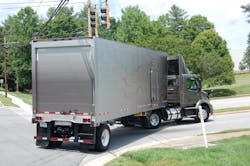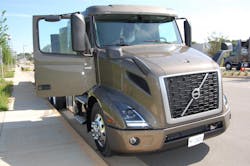WINSTON-SALEM, NC. The main reason driving Volvo Trucks North America (VTNA) to introduce the new VNR family of trucks to replace its VNM model is a fairly simple one, according to Chris Stadler, the OEM’s product marketing manager for regional haul: “The VNM is an aged truck; it was time for a refresh. We needed a more adaptable truck, too: one that can operate in the city and on the highway.”
Yet Stadler also explained to Fleet Owner that shifting freight transportation patterns plus the need to address a growing shortage of truck drivers accelerated VTNA’s decision to build the VNR: a family of trucks that took over two years to design in part due to the input of 2,000 customers and drivers.
“Even with autonomous vehicles we’ll need drivers; there’s going to be a need for them [drivers] for quite a while,” he said. “We need to make sure they are productive, rested, comfortable, and less distracted.”
Stadler noted that while the regional market is changing, the OEM can’t bank on any one segment doing better than another.
“There are lots of good opportunities in the regional market: bulk haul, tanker, city delivers, P&D [pickup and delivery], flatbed, construction, and LTL,” he emphasized. “But there are also lots of changes, too. We had anticipated more regional versus long haul when the expanded Panama Canal opened. Also the oil and natural gas fields are only slowly recovering.”
Those are some of the reasons why demand for regional trucks slumped in recent years. For example, according to VTNA data, in 2014 the regional haul market accounted for 66,300 units, jumping up to 72,320 units in 2015. But in 2016, demand dropped to 54,029 units. Comparing year-to-date regional market sales through March 2016 to year-to-date sales through March 2017, the decline is steeper: 15,519 units against 11,762 units, respectively.
Still, Magnus Koeck, VTNA’s vice president of marketing and brand management, stressed that 54,000-plus units remains “a big market.”
Perhaps the biggest change in the regional sector, though, is how truck OEMs are now getting more focused on driver recruitment and retention issues, said Stadler, as less and less people want to get into trucking.
“They don’t want to be gone weeks at a time anymore and that’s why LTL fleets, for example, are creating more hubs and distribution points: that leads to more short hauls,” Stadler said. “We’ve also heard there is more demand for timed deliveries, too. So we want to put the right truck into the right application and not just for today but for five to 15 years down the road.”
That means adding more electronics and “gadgets,” from Stadler’s view, to give the “younger generation” vehicle operating parameters that appeals to them, while keeping it “intuitive” for the current generation of truck drivers.
“It’s about making it easier for all generations [of truck drivers] to adapt to using it,” he stressed. “We want to make sure it can be operated by those who’ve never seen a manual transmission in their life. Make it adaptable.”
It also must be a more cost-effective truck as well, Stadler stressed. For example, he said the VNR’s improved aerodynamic profile can boost fuel economy 1% compared to the previous VNM model, while the VNR’s Volvo GHG2017 powertrain can offer a further 2.5% to 3.5% gain in fuel efficiency versus the VNM.
“Regional can longer be a hand-me-down from long haul; it must offer better performance and fuel efficiency, too,” Stadler pointed out. “While regional [fleets] don’t usually think about fuel economy, fuel is still their biggest cost. So getting an extra one to two miles per gallon when they are operating on the highway is an additional savings in the wallet for them.”
Regional customers also keep truck a long time, he added: five to 15 years for some of them. “They’ll start it in bulk hauling, then move to flatbed and then finally to dry van. They use the truck to its full potential,” he explained. “My mission is to give the customer a truck that can do all of those jobs.”
About the Author
Sean Kilcarr
Editor in Chief
Sean Kilcarr is a former longtime FleetOwner senior editor who wrote for the publication from 2000 to 2018. He served as editor-in-chief from 2017 to 2018.

